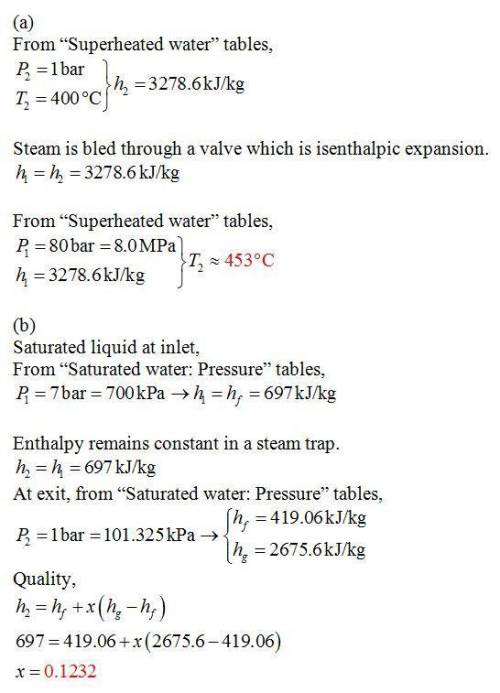
Engineering, 07.03.2020 04:04 gandalfhan
Valves on steam lines are commonly encountered and you should know how they work. For most valves, the change in velocity of the fluid flow is negligible. Apply this principle to solve the following problems. a. A pressure gauge on a high-pressure steam line reads 80 bar absolute, but temperature measurement is unavailable inside the pipe. A small quantity of steam is bled out through a valve to atmospheric pressure at 1 bar. A thermocouple placed in the bleed stream reads 400°C. What is the temperature inside the high-pressure duct? b. Steam traps are common process devices used on the lowest points of steam lines to remove condensate. By using a steam trap, a chemical process can be supplied with so-called dry steam, i. e., steam free of condensate. As condensate forms due to heat losses in the supply piping, the liquid runs downward to the trap. As liquid accumulates in the steam trap, it causes a float mechanism to move. The float mechanism is attached to a valve, and when the float reaches a control level, the valve opens to release ac

Answers: 1


Another question on Engineering

Engineering, 04.07.2019 18:10
Apump is used to circulate hot water in a home heating system. water enters the well-insulated pump operating at steady state at a rate of 0.42 gal/min. the inlet pressure and temperature are 14.7 lbf/in.2, and 180°f, respectively; at the exit the pressure is 60 lbf/in.2 the pump requires 1/15 hp of power input. water can be modeled as an incompressible substance with constant density of 60.58 lb/ft3 and constant specific heat of 1 btu/lb or. neglecting kinetic and potential energy effects, determine the temperature change, in °r, as the water flows through the pump.
Answers: 1

Engineering, 04.07.2019 18:20
Inadequate stores control is not an obstacle to effective work order system. (clo4) a)-true b)-false
Answers: 3

Engineering, 04.07.2019 19:20
At steady state, air at 200 kpa, 325 k, and mass flow rate of 0.5 kg/s enters an insulated duct having differing inlet and exit cross-sectional areas. the inlet cross-sectional area is 6 cm2. at the duct exit, the pressure of the air is 100 kpa and the velocity is 250 m/s. neglecting potential energy effects and modeling air as an 1.008 kj/kg k, determine ideal gas with constant cp = (a) the velocity of the air at the inlet, in m/s. (b) the temperature of the air at the exit, in k. (c) the exit cross-sectional area, in cm2
Answers: 2

Engineering, 06.07.2019 04:10
Consider a power plant with water as the working fluid that operates on an ideal rankine cycle. it has a net power output of 45mw. superheated steam enters the turbine at 7mpa and 500°c (h=3411.4 kj/kg; s=6.8 kj/kg k) and is cooled in the condenser at a pressure of 10 kpa by running cooling water from a lake through the tubes of the condenser at a rate of 2000 kg/s. (a) show the cycle on a t-s diagram (a right schematic is fine - you do not need to calculate the temperatures at each point); (b)-determine the work done by the turbine and the pump in kj/kg; (c)-the mass flow rate of water used by the power plant; (d)-the thermal efficiency of the cycle; (e)-the temperature rise of the cooling water. assume the cooling water is incompressible with cp 4.18 kj/kg°c.
Answers: 3
You know the right answer?
Valves on steam lines are commonly encountered and you should know how they work. For most valves, t...
Questions

Mathematics, 23.10.2019 14:50

Mathematics, 23.10.2019 14:50

Mathematics, 23.10.2019 14:50

Chemistry, 23.10.2019 14:50

Mathematics, 23.10.2019 14:50

Physics, 23.10.2019 14:50

Mathematics, 23.10.2019 14:50

Mathematics, 23.10.2019 14:50

Business, 23.10.2019 14:50


Mathematics, 23.10.2019 14:50

English, 23.10.2019 14:50

English, 23.10.2019 14:50

Mathematics, 23.10.2019 14:50

English, 23.10.2019 14:50

English, 23.10.2019 14:50



English, 23.10.2019 14:50




